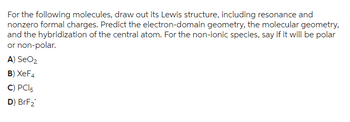
Chemistry
10th Edition
ISBN: 9781305957404
Author: Steven S. Zumdahl, Susan A. Zumdahl, Donald J. DeCoste
Publisher: Cengage Learning
expand_more
expand_more
format_list_bulleted
Concept explainers
Question

Transcribed Image Text:For the following molecules, draw out its Lewis structure, including resonance and
nonzero formal charges. Predict the electron-domain geometry, the molecular geometry,
and the hybridization of the central atom. For the non-ionic species, say if it will be polar
or non-polar.
A) SeO₂
B) XeF4
C) PCL5
D) BrF₂
Expert Solution
This question has been solved!
Explore an expertly crafted, step-by-step solution for a thorough understanding of key concepts.
This is a popular solution
Trending nowThis is a popular solution!
Step by stepSolved in 4 steps with 18 images

Knowledge Booster
Learn more about
Need a deep-dive on the concept behind this application? Look no further. Learn more about this topic, chemistry and related others by exploring similar questions and additional content below.Similar questions
- 7.Draw the Lewis structure first, then predict the molecular shape and electron group geometry for each of the following: CS2 H3O+ PBr3 SiCl4arrow_forwardSection 3: Worksheet (continued) 4. H;0 |Total number of valence electrons: Lewis structure: 3D sketch: | Molecular shape / bond angle Polar or nonpolar?arrow_forwardGiven the below compounds, draw the appropriate Lewis structure, calculate the formal charge on each atom, indicate the VSEPR notation, determine the electron and molecular geometry using VSEPR theory, identify the hybridization of all interior atom(s), and make a sketch of the molecule based on the valence bond theory. a) OSBr2 b) SCl4 c) CH3OHarrow_forward
- Find the hybrid orbital type for each atom, the carbon-carbon-oxygen bond angle, the molecular geometry of oxygen, and the number of sigma and pi bonds in the molecule.arrow_forward3. Using the Lewis structure predict the geometrical structures of the following ions and state the hybridization of the central atom. Ion Electron Geometry Molecular Formal Charge Central Atom Geometry of Central Hybridization Atom N3 CO2- NO3- BF4arrow_forwardWhat molecules have trigonal planar ELECTRON PAIR GEOMETRY A) O3 B) HCl C) ClO3- D)NaCl E)CH2O F) BF3 G) BrF3arrow_forward
- What are the angles a and b in the actual molecule of which this is a Lewis structure? Н Н Н Н olb Н Note for advanced students: give the ideal angles, and don't worry about small differences from the ideal that might be caused by the fact that different electron groups may have slightly different sizes. 18 Ar b = ||arrow_forwardDraw the Lewis structure for NH3 . Is the molecule polar or nonpolar? What is the electronic geometry, molecular geometry, and hybridization of nitrogen? Lastly, draw the 3-D structure of the entire molecule.arrow_forwardFor each, draw the lewis structure, a 3D Structure including Angles, Electron Pair Geometry, Molecular Geometry, and whether it is "Polar or Non/Polar" A) SF6 B) CH2Oarrow_forward
- 9) HCCCO₂H, is an organic hydrocarbon. a) Draw a geometrically accurate structure so that the formal charge of each atom is zero identifying the bond angles (Draw it BIG!). b) Identify the hybridization about each atom (not H) forming a bond c) How many o or π bonds are there in this molecule d) The combustion of the hydrocarbon produces carbon dioxide and water in the gaseous state. Use average bond enthalpies to determine enthalpy of reactionarrow_forwardWhat are the angles a and b in the actual molecule of which this is a Lewis structure? H H H C H a a = C b = ⁰ C H Note for advanced students: give the ideal angles, and don't worry about small differences from the ideal that might be caused by the fact that different electron groups may have slightly different sizes. H Xarrow_forwardWhich molecules have an octahedral molecular structure A) SbF6 - B)HCl C) BrF5 D) NaCl E) SnCl6 2-arrow_forward
arrow_back_ios
arrow_forward_ios
Recommended textbooks for you
 ChemistryChemistryISBN:9781305957404Author:Steven S. Zumdahl, Susan A. Zumdahl, Donald J. DeCostePublisher:Cengage Learning
ChemistryChemistryISBN:9781305957404Author:Steven S. Zumdahl, Susan A. Zumdahl, Donald J. DeCostePublisher:Cengage Learning ChemistryChemistryISBN:9781259911156Author:Raymond Chang Dr., Jason Overby ProfessorPublisher:McGraw-Hill Education
ChemistryChemistryISBN:9781259911156Author:Raymond Chang Dr., Jason Overby ProfessorPublisher:McGraw-Hill Education Principles of Instrumental AnalysisChemistryISBN:9781305577213Author:Douglas A. Skoog, F. James Holler, Stanley R. CrouchPublisher:Cengage Learning
Principles of Instrumental AnalysisChemistryISBN:9781305577213Author:Douglas A. Skoog, F. James Holler, Stanley R. CrouchPublisher:Cengage Learning Organic ChemistryChemistryISBN:9780078021558Author:Janice Gorzynski Smith Dr.Publisher:McGraw-Hill Education
Organic ChemistryChemistryISBN:9780078021558Author:Janice Gorzynski Smith Dr.Publisher:McGraw-Hill Education Chemistry: Principles and ReactionsChemistryISBN:9781305079373Author:William L. Masterton, Cecile N. HurleyPublisher:Cengage Learning
Chemistry: Principles and ReactionsChemistryISBN:9781305079373Author:William L. Masterton, Cecile N. HurleyPublisher:Cengage Learning Elementary Principles of Chemical Processes, Bind...ChemistryISBN:9781118431221Author:Richard M. Felder, Ronald W. Rousseau, Lisa G. BullardPublisher:WILEY
Elementary Principles of Chemical Processes, Bind...ChemistryISBN:9781118431221Author:Richard M. Felder, Ronald W. Rousseau, Lisa G. BullardPublisher:WILEY

Chemistry
Chemistry
ISBN:9781305957404
Author:Steven S. Zumdahl, Susan A. Zumdahl, Donald J. DeCoste
Publisher:Cengage Learning

Chemistry
Chemistry
ISBN:9781259911156
Author:Raymond Chang Dr., Jason Overby Professor
Publisher:McGraw-Hill Education

Principles of Instrumental Analysis
Chemistry
ISBN:9781305577213
Author:Douglas A. Skoog, F. James Holler, Stanley R. Crouch
Publisher:Cengage Learning

Organic Chemistry
Chemistry
ISBN:9780078021558
Author:Janice Gorzynski Smith Dr.
Publisher:McGraw-Hill Education

Chemistry: Principles and Reactions
Chemistry
ISBN:9781305079373
Author:William L. Masterton, Cecile N. Hurley
Publisher:Cengage Learning

Elementary Principles of Chemical Processes, Bind...
Chemistry
ISBN:9781118431221
Author:Richard M. Felder, Ronald W. Rousseau, Lisa G. Bullard
Publisher:WILEY